On one of my trips to the recycling place I scored a windsurfing board. On another trip I scored an old laser sail. The obvious had to be done... a bamboo windsurfing rig!
I have written a rather wordy account of its construction at Instructables.com, so I'll spare you the details here. There is also a video on Youtube.
 I'll start with a picture of the finished windsurfer so you know I'm not just making stuff up!
I'll start with a picture of the finished windsurfer so you know I'm not just making stuff up!
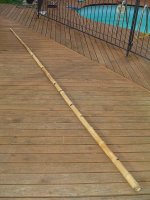 This is the mast, a long piece of bamboo. I drilled holes in each partition, to prevent it from cracking. These are
covered in tape to prevent water entering.
This is the mast, a long piece of bamboo. I drilled holes in each partition, to prevent it from cracking. These are
covered in tape to prevent water entering.
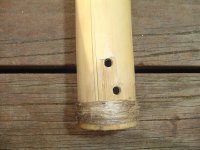 Here you can see how I tried to prevent the bottom of the mast cracking (It gets a universal joint inserted). The skin was
peeled off the bamboo, some superglue sprinkled on and then I wrapped twine around. The hole drilled is for the downhaul.
Here you can see how I tried to prevent the bottom of the mast cracking (It gets a universal joint inserted). The skin was
peeled off the bamboo, some superglue sprinkled on and then I wrapped twine around. The hole drilled is for the downhaul.
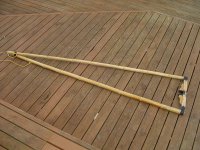 The wishbone boom is also made from bamboo, with a short piece of wood as a crosspiece to keep the booms apart. The back
end has just been drilled through and then lashed together.
The wishbone boom is also made from bamboo, with a short piece of wood as a crosspiece to keep the booms apart. The back
end has just been drilled through and then lashed together.
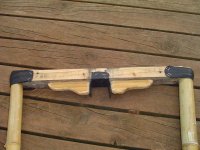 The two pretty curved blocks act as boom jaws to locate the boom on the mast. They are made wider than the mast to prevent
crushing it when the boom is tilted. The black rubber is as padding, and made from tractor inner tube. The black rubber that goes
around the bamboo is made from bike inner tube, and protects the lashings which are underneath.
The two pretty curved blocks act as boom jaws to locate the boom on the mast. They are made wider than the mast to prevent
crushing it when the boom is tilted. The black rubber is as padding, and made from tractor inner tube. The black rubber that goes
around the bamboo is made from bike inner tube, and protects the lashings which are underneath.
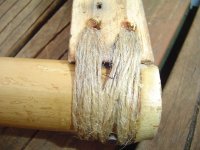 Without the innertube protection, here you can see how the bamboo was joined to the cross piece. First with a big nail and then
with a generous lashing of ordinary garden twine. A light sprinkling of superglue helps it stay in place and saves having to
tie a knot.
Without the innertube protection, here you can see how the bamboo was joined to the cross piece. First with a big nail and then
with a generous lashing of ordinary garden twine. A light sprinkling of superglue helps it stay in place and saves having to
tie a knot.
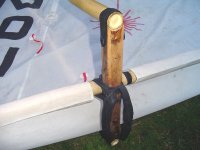 The mast is simply lashed to the boom using a strip of inner tube. Never tie an actual knot in inner tube, you'll never get
it out! Just tuck one end under the other, like the start of tying your shoe laces.
The mast is simply lashed to the boom using a strip of inner tube. Never tie an actual knot in inner tube, you'll never get
it out! Just tuck one end under the other, like the start of tying your shoe laces.
 The sail is just an old laser sail with a bit chopped off the bottom. Another bit was taken out where the boom attaches to the mast,
and two new eyelets were made for the downhaul and outhaul.
The sail is just an old laser sail with a bit chopped off the bottom. Another bit was taken out where the boom attaches to the mast,
and two new eyelets were made for the downhaul and outhaul.
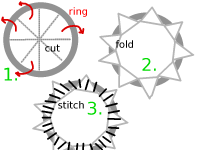 This is how you can reinforce an eyelet in a sail using a ring.
This is how you can reinforce an eyelet in a sail using a ring.
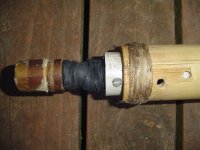 I tried lots of simple ideas with bits of string and blocks, but in the end made a proper universal joint. So much easier to
sail now! The downhaul passes through the hole seen and prevents the universal joint from getting out of the mast.
I tried lots of simple ideas with bits of string and blocks, but in the end made a proper universal joint. So much easier to
sail now! The downhaul passes through the hole seen and prevents the universal joint from getting out of the mast.
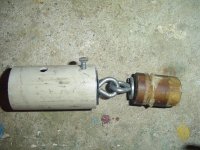 This shows the two eyebolts that are the basis of the design. The one that goes into the pvc goes through a little block of wood
screwed in the end of the pvc tube and has a washer and locking nuts on the end. It can rotate freely.
This shows the two eyebolts that are the basis of the design. The one that goes into the pvc goes through a little block of wood
screwed in the end of the pvc tube and has a washer and locking nuts on the end. It can rotate freely.
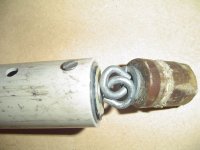 If the eye bolts were ever to get into this position while sailing (quite likely), then stuff would break. Bad!
If the eye bolts were ever to get into this position while sailing (quite likely), then stuff would break. Bad!
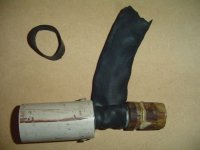 A strip of innertube is wrapped tightly around the eye bolts to keep them spaced apart, while still allowing full motion of
the mast. The little ring of innertube is placed around the wrapping to keep it in place, so a knot isn't needed.
A strip of innertube is wrapped tightly around the eye bolts to keep them spaced apart, while still allowing full motion of
the mast. The little ring of innertube is placed around the wrapping to keep it in place, so a knot isn't needed.
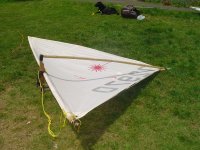 Here is the completed rig, ready to be put on the board. The yellow rope is for pulling up the sail after a spill, and is made
from a rope that floats and doesn't absorb water. Big knots for grip.
Here is the completed rig, ready to be put on the board. The yellow rope is for pulling up the sail after a spill, and is made
from a rope that floats and doesn't absorb water. Big knots for grip.
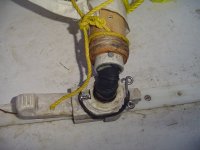 This shows the mast fitted to the board.
This shows the mast fitted to the board.
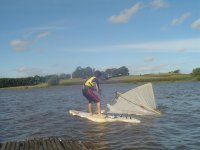 Pulling up the sail is easy to do, as the rig is very light. You can see the mast bending quite a lot.
Pulling up the sail is easy to do, as the rig is very light. You can see the mast bending quite a lot.
9 December 2010
